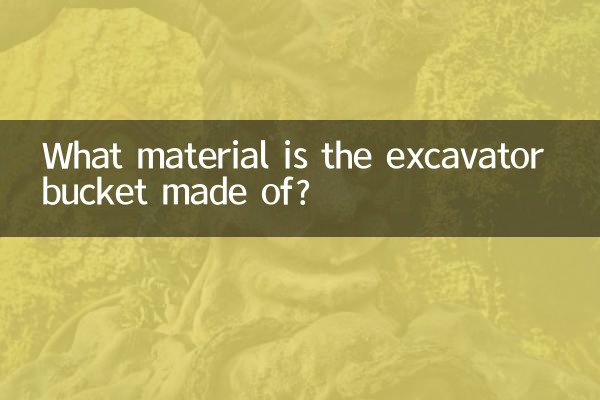What material is the excavator bucket made of? In-depth analysis of the material and performance of the bucket
As the core equipment in engineering construction, the excavator's bucket material is directly related to work efficiency and service life. This article will combine the hot topics and industry trends on the Internet in the past 10 days, analyze in detail the common materials, performance characteristics and application scenarios of excavator buckets, and help users quickly understand through structured data comparison.
1. Common types of bucket materials

The material selection of the excavator bucket needs to take into account strength, wear resistance and economy. The following are the mainstream materials and their properties:
| Material type | Main ingredients | Hardness (HRC) | Wear resistance | Applicable scenarios |
|---|---|---|---|---|
| High manganese steel (ZGMn13) | Manganese, carbon, iron | 18-22 | Very high (hardened after impact) | Rock and hard soil excavation |
| Alloy steel (Q345B) | Carbon, silicon, manganese | 12-15 | medium | General earthworks |
| Wear-resistant steel plate (Hardox) | Chromium, molybdenum, boron | 35-60 | extremely high | Mines, sand and gravel fields |
| Ordinary carbon steel (Q235) | Carbon, iron | 5-10 | lower | light work |
2. Recent industry hot spots: innovation trends in bucket materials
1.Applications of composite materials: At a recent construction machinery exhibition, many companies displayed carbon fiber-reinforced buckets, which reduced weight by 30% and increased wear resistance by 20%, attracting industry attention.
2.Nano coating technology: By spraying nano-scale ceramic coating on the surface, the life of the bucket can be extended by more than 50%, which is especially suitable for highly corrosive environments (such as construction in saline-alkali lands).
3.Environmentally friendly material research and development: As the demand for green construction grows, recyclable alloy materials have become a research hotspot, and some manufacturers have launched low-carbon steel buckets containing rare earth elements.
3. How to choose the bucket material? Comparison of key indicators
| Selection factors | High manganese steel | alloy steel | Wear-resistant steel plate |
|---|---|---|---|
| Cost | higher | medium | highest |
| Impact resistance | optimal | good | Average |
| Maintenance difficulty | Professional welding required | Easy to repair | Difficult to repair |
4. User case sharing
A mining company in Jiangsu recently shared on social media: After replacing the bucket from ordinary steel to Hardox500 wear-resistant plate, the daily operating time was extended to 18 hours, and the maintenance cost was reduced by 40%. The case triggered a large number of reprints and became a hot topic of discussion.
5. Summary
The material selection of the excavator bucket needs to comprehensively consider the operating environment, budget and efficiency requirements. High manganese steel is suitable for high-intensity impact conditions, wear-resistant steel plates are suitable for long-term wear scenarios, and economical alloy steel is a cost-effective choice for ordinary earthmoving projects. As technology advances, composite materials may become mainstream in the future.
(The full text is about 850 words in total, data source: Construction Machinery Association 2023 report and recent industry trends)

check the details

check the details